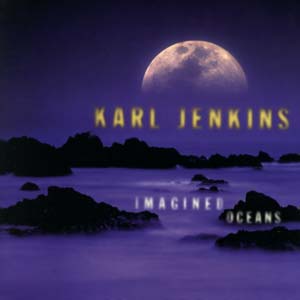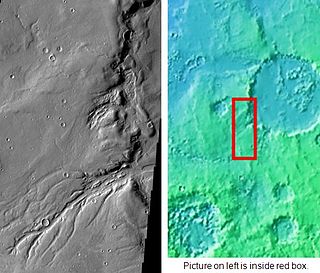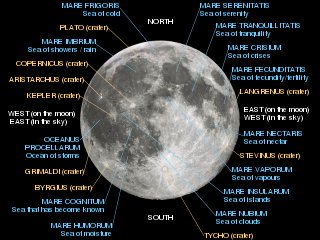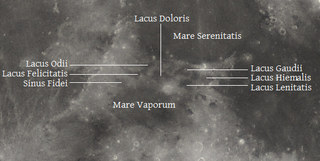
Montes Haemus is a mountain range that forms the southwestern edge of the Mare Serenitatis basin on the Moon. They form a less prominent mirror image of the Montes Apenninus range to the west, and curve up to nearly join at the northern end. The eastern edge terminates with the Promontorium Archerusia, to the northwest of the crater Plinius. This end reaches a gap where the Mare Serenitatis to the north joins the Mare Tranquillitatis to the south.

The Lacus Iuturnae — or Lacus Juturnae or Spring of Juturna — is the name of a formal pool built by the Romans near a spring or well in the Roman Forum. The pool was part of a shrine dedicated to the water nymph Juturna, and the name Lacus Iuturnae is also used for the spring and the shrine, both next to the pool.
LacusCurtius is a website specializing in ancient Rome, currently hosted on a server at the University of Chicago. It went online on August 26, 1997; in May 2018 it had "3642 webpages, 761 photos, 755 drawings & engravings, 120 plans, 127 maps." The site is the creation of William P. Thayer.

The Lacus Curtius was a mysterious pit or pool in the ground in the Forum Romanum. The area where the Forum would later be built was originally likely a lake, as the area it was in is known to have been surrounded by brooks and marshes. One part of the area was never drained, but gradually became smaller until only a basin, known as the Lacus Curtius, was left. Its nature and significance in Rome's early history is uncertain, and several conflicting stories exist about its history.

Bowen is a small lunar impact crater that is located to the southwest of the Montes Haemus, on the edge of a small lunar mare named the Lacus Doloris. It was named after American astronomer Ira S. Bowen. It is distinguished only by having a relatively flat floor, rather than being bowl-shaped like most small craters. Bowen was previously designated Manilius A. The crater Manilius is located to the south, at the opposite shore of the Lacus.

Mobile Suit Gundam SEED: Special Edition are three special edition movies that were released following the conclusion of Gundam SEED.

Lacus Clyne is a fictional character introduced in the Japanese science fiction anime television series Mobile Suit Gundam SEED and appearing in the sequel Mobile Suit Gundam SEED Destiny, both part of the Gundam franchise by Sunrise. In the start of Mobile Suit Gundam SEED, Lacus is a good natured and popular female vocalist from the space colony PLANT. Born as a genetically enhanced human, a Coordinator, Lacus is introduced when she is found in space by the battleship the Archangel, a ship of regular humans, the Naturals. Late in the war between the races of Coordinators and Naturals, Lacus becomes the co-leader of the Clyne Faction, joining with the Archangel to stop both sides from fighting. Lacus is voiced in the Japanese series by Rie Tanaka. In the Ocean English dub, her speaking voiced is done by Chantal Strand, while Jillian Michaels does her singing voice. In the NYAV English dub, she is voiced by Stephanie Sheh.

Lacus Felicitatis is a small patch of the lunar surface that has been inundated by flows of lava, leaving a level patch with a lower albedo than the surrounding ground. It is located in Terra Nivium, an area of continental ground to the north of the Mare Vaporum. About 70–80 km to the northeast of this area are the Montes Haemus, along the southwestern edge of the Mare Serenitatis.

Castrum doloris is a name for the structure and decorations sheltering or accompanying the catafalque or bier that signify the prestige or high estate of the deceased. A castrum doloris might feature an elaborate baldachin and would include candles, possibly flowers, and in most cases coats of arms, epitaphs and possibly allegorical statues. Many extensive castra doloris can be traced to the customs of 17th century and 18th century or even earlier, since Pope Sixtus V's funeral arrangements included a castrum doloris in the late 16th Century.

Lacus Mortis, Latin for "Lake of Death", is a plain of basaltic lava flows in the northeastern part of the Moon. It lies just to the south of the elongated Mare Frigoris, being separated by a slender arm of rugged ground. To the south is the Lacus Somniorum, separated from this mare by the joined craters Plana and Mason, and a strip of uneven surface.

Released in 1998, Imagined Oceans is an album by Welsh composer Karl Jenkins. This work was inspired by thirteen lunar mare for which the tracks are titled. The musical style is similar to Jenkins's Adiemus compositions and each track explores the meaning of its Latin name through various musical techniques. Unlike most of the Adiemus pieces, the lyrics for Imagined Oceans consist of syllables from the tracks' titles rather than invented text.

Maurice J. ("Moe") Murphy Jr. was the New Hampshire Attorney General and an appointed United States Senator.

The World Day of the Sick is a feast day of the Roman Catholic Church which was instituted on 13 May 1992 by Pope John Paul II. Beginning on 11 February 1993, it is celebrated every year on the commemoration of Our Lady of Lourdes, for all believers seeks to be "a special time of prayer and sharing, of offering one's suffering".

Semeykin is a crater in the Ismenius Lacus quadrangle on Mars. It is located at 41.8° north latitude and 351.4° west longitude. The crater measures approximately 74 kilometers in diameter and was named after Boris Semeykin, a Soviet astronomer (1900–1937).

Lobate debris aprons (LDAs) are geological features on Mars, first seen by the Viking Orbiters, consisting of piles of rock debris below cliffs. These features have a convex topography and a gentle slope from cliffs or escarpments, which suggest flow away from the steep source cliff. In addition, lobate debris aprons can show surface lineations as do rock glaciers on the Earth.

Oti Fossae is a group of fossae (troughs) in the Phoenicis Lacus quadrangle on Mars, located at 9.3° S and 116.8° W. It is 370 km long and was named after a classical albedo feature.

Jingpo Lacus is a lake in the north polar region of Titan, the planet Saturn's largest moon. It and similarly sized Ontario Lacus are the largest known bodies of liquid on Titan after the three maria. It is composed of liquid hydrocarbons. It is west of Kraken Mare at 73° N, 336° W, roughly 240 km long, similar to the length of Lake Onega on Earth. Its namesake is Jingpo Lake, a scenic lake in China.

Ladoga Lacus is a geographical feature on Saturn's largest moon, Titan, named after Lake Ladoga, Russia. It is one of a number of "methane lakes" found in Titan's north polar region.




















